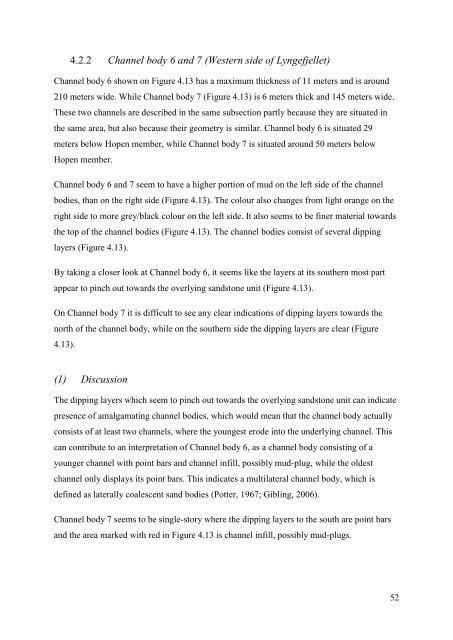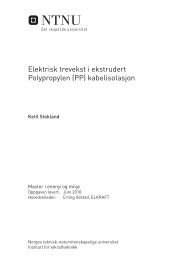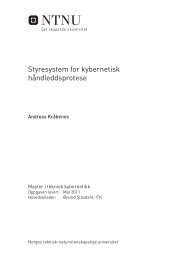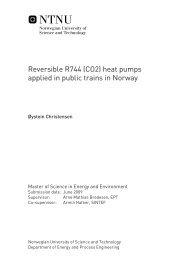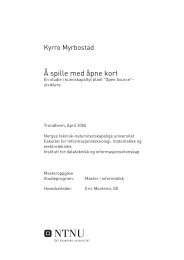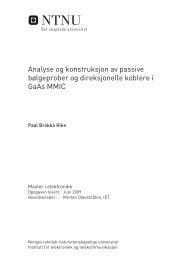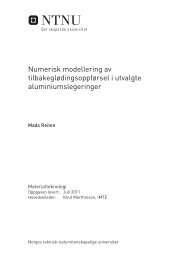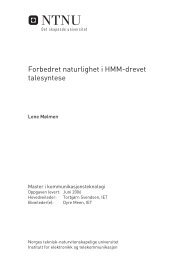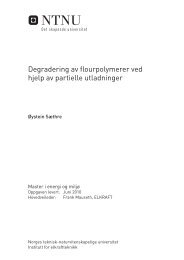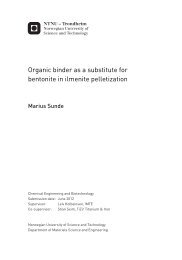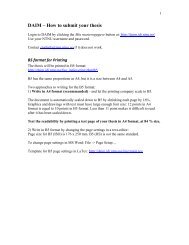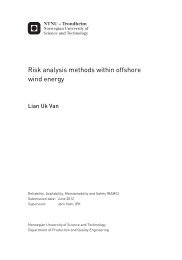Visualize and interpret the geometry, heterogeneity and lateral ...
Visualize and interpret the geometry, heterogeneity and lateral ...
Visualize and interpret the geometry, heterogeneity and lateral ...
You also want an ePaper? Increase the reach of your titles
YUMPU automatically turns print PDFs into web optimized ePapers that Google loves.
4.2.2 Channel body 6 <strong>and</strong> 7 (Western side of Lyngefjellet)Channel body 6 shown on Figure 4.13 has a maximum thickness of 11 meters <strong>and</strong> is around210 meters wide. While Channel body 7 (Figure 4.13) is 6 meters thick <strong>and</strong> 145 meters wide.These two channels are described in <strong>the</strong> same subsection partly because <strong>the</strong>y are situated in<strong>the</strong> same area, but also because <strong>the</strong>ir <strong>geometry</strong> is similar. Channel body 6 is situated 29meters below Hopen member, while Channel body 7 is situated around 50 meters belowHopen member.Channel body 6 <strong>and</strong> 7 seem to have a higher portion of mud on <strong>the</strong> left side of <strong>the</strong> channelbodies, than on <strong>the</strong> right side (Figure 4.13). The colour also changes from light orange on <strong>the</strong>right side to more grey/black colour on <strong>the</strong> left side. It also seems to be finer material towards<strong>the</strong> top of <strong>the</strong> channel bodies (Figure 4.13). The channel bodies consist of several dippinglayers (Figure 4.13).By taking a closer look at Channel body 6, it seems like <strong>the</strong> layers at its sou<strong>the</strong>rn most partappear to pinch out towards <strong>the</strong> overlying s<strong>and</strong>stone unit (Figure 4.13).On Channel body 7 it is difficult to see any clear indications of dipping layers towards <strong>the</strong>north of <strong>the</strong> channel body, while on <strong>the</strong> sou<strong>the</strong>rn side <strong>the</strong> dipping layers are clear (Figure4.13).(1) DiscussionThe dipping layers which seem to pinch out towards <strong>the</strong> overlying s<strong>and</strong>stone unit can indicatepresence of amalgamating channel bodies, which would mean that <strong>the</strong> channel body actuallyconsists of at least two channels, where <strong>the</strong> youngest erode into <strong>the</strong> underlying channel. Thiscan contribute to an <strong>interpret</strong>ation of Channel body 6, as a channel body consisting of ayounger channel with point bars <strong>and</strong> channel infill, possibly mud-plug, while <strong>the</strong> oldestchannel only displays its point bars. This indicates a multi<strong>lateral</strong> channel body, which isdefined as <strong>lateral</strong>ly coalescent s<strong>and</strong> bodies (Potter, 1967; Gibling, 2006).Channel body 7 seems to be single-story where <strong>the</strong> dipping layers to <strong>the</strong> south are point bars<strong>and</strong> <strong>the</strong> area marked with red in Figure 4.13 is channel infill, possibly mud-plugs.52


